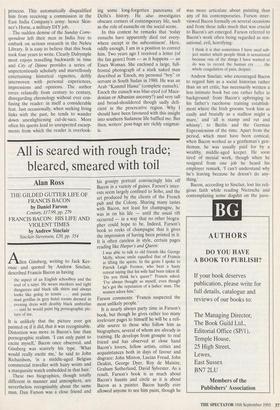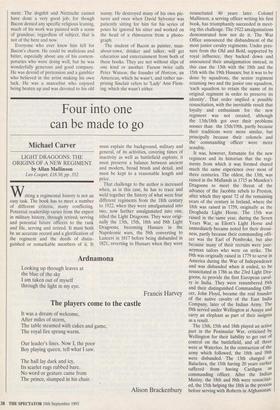All is seared with rough trade; bleared, smeared with toil
Alan Ross
Alen Ginsberg, writing to Jack Ker- ouac and quoted by Andrew Sinclair, described Francis Bacon as having
the aspect of an English schoolboy and the soul of a satyr. He wears sneakers and tight dungarees and black silk shirts and always looks like going to tennis ... and paints mad gorillas in grey hotel rooms dressed in evening dress with deathly black umbrellas — said he would paint big pornographic pic- ture of me.
It is unlikely that the picture ever got painted o4 if it did, that it was recognisable. Distortion was more in Bacon's line than pornographic realism. 'I can only paint to excite myself,' Bacon once observed, and Ginsberg was scarcely his type. 'What would really excite me,' he said to John Richardson, Is a middle-aged Belgian commercial traveller with hairy wrists and a marquesite watch embedded in that hair.'
These two biographies, though totally different in manner and atmosphere, are nevertheless recognisably about the same man. Dan Farson was a close friend and
his gossipy portrait convincingly hits off Bacon in a variety of guises. Farson's inter- ests seem largely confined to Soho, and the art produced by the clients of the French pub and the Colony. Sharing many tastes with Bacon, not least for champagne, he was in on his life — until the usual rift occurred — in a way that no other biogra- pher could hope to be. Indeed, Farson's book so reeks of champagne that it gives the impression of having been printed in it. It is often careless in style, certain pages reading like Harper's and Queen:
I was able to talk to old friends like George Melly, whose smile equalled that of Francis in lifting the spirits. In the gents I spoke to Patrick Leigh Fermor, who beat a hasty retreat saying that his wife had been taken ill. `Do you think he's queer?' Francis asked. `I've always thought so myself, even though he's got the reputation of a ladies' man. The women adore him.'
Farson comments: 'Francis suspected the most unlikely people.'
It is nearly always party time in Farson's book, but though he gives rather too many irrelevant pages to himself he will be a reli- able source to those who follow him as biographers, several of whom are already in training. He develops from groupie to real friend and has observed at close hand Bacon's lovers, fellow artists, critics and acquaintances both in days of favour and disgrace: John Minton, Lucian Freud, John Deakin, George Dyer, Roy de Maistre, Graham Sutherland, David Sylvester. As a result, Farson's book is as much about Bacon's haunts and circle as it is about Bacon as a painter. Bacon hardly ever allowed anyone to see him paint, though he was more articulate about painting than any of his contemporaries. Farson inter- viewed Bacon formally on several occasions and from these talks much that was crucial to Bacon's art emerged. Farson referred to Bacon's work often being regarded as sen- sational, evil, horrifying:
I think it is that sometimes I have used sub- ject matter which people think is sensational because one of the things I have wanted to do was to record the human cry ... the whole coagulation of pain, despair.
Andrew Sinclair, who encouraged Bacon to regard him as a social historian rather than an art critic, has necessarily written a less intimate book but one rather fuller in background: from Bacon's upbringing in his father's racehorse training establish- ment where the Irish grooms 'took him as easily and brutally as a stallion might a mare,' and 'all is stamp and rut and whinny', to Berlin and the German Expressionism of the time. Apart from the period, which must have been comical, when Bacon worked as a gentleman's gen- tleman, he was usually paid for by a wealthy, middle-aged keeper. He soon tired of menial work, though when he resigned from one job he heard his employer remark, 'I can't understand why he's leaving because he doesn't do any- thing.'
Bacon, according to Sinclair, lost his reli- gious faith while reading Nietzsche and contemplating some dogshit on the pave- ment. The dogshit and Nietzsche cannot have done a very good job, for though Bacon denied any specific religious leaning, much of his work was painted with a sense of grandeur, regardless of subject, that is not of the here and now.
Everyone who ever knew him fell for Bacon's charm. He could be malicious and bitter, especially about any of his contem- poraries who were doing well, but he was wonderfully generous and good company. He was devoid of pretension and a gambler who believed in the artist making his own luck. He was a masochist who enjoyed being beaten up and was devoted to his old nanny. He destroyed many of his own pic- tures and once when David Sylvester was patiently sitting for him for his series of poses he ignored his sitter and worked on the head of a rhinoceros from a photo- graph.
The student of Bacon as painter, man- about-town, drinker and talker, will get education and entertainment from both of these books. They are not without slips of one kind or another. Farson twice calls Peter Watson, the founder of Horizon, an American, which he wasn't, and rather sur- prising Sinclair refers to 'Lady' Ann Flem- ing, which she wasn't either.



































































 Previous page
Previous page